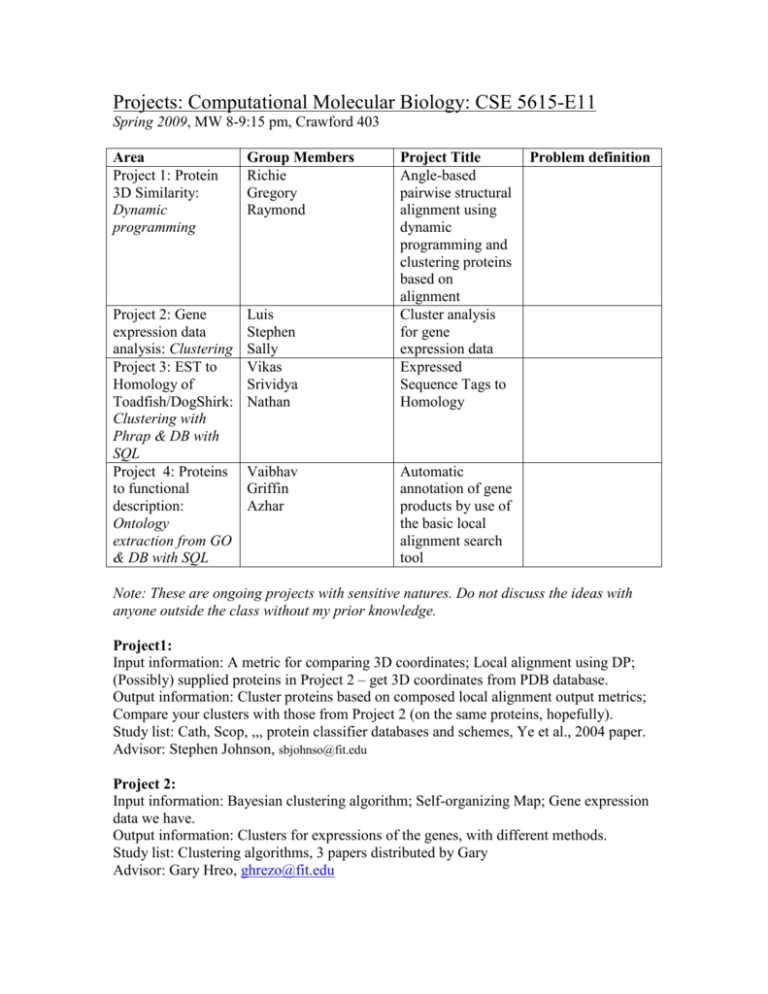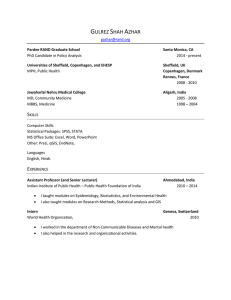Computational Molecular Biology - Department of Computer Sciences
advertisement

Projects: Computational Molecular Biology: CSE 5615-E11 Spring 2009, MW 8-9:15 pm, Crawford 403 Area Project 1: Protein 3D Similarity: Dynamic programming Group Members Richie Gregory Raymond Project 2: Gene expression data analysis: Clustering Project 3: EST to Homology of Toadfish/DogShirk: Clustering with Phrap & DB with SQL Project 4: Proteins to functional description: Ontology extraction from GO & DB with SQL Luis Stephen Sally Vikas Srividya Nathan Vaibhav Griffin Azhar Project Title Angle-based pairwise structural alignment using dynamic programming and clustering proteins based on alignment Cluster analysis for gene expression data Expressed Sequence Tags to Homology Problem definition Automatic annotation of gene products by use of the basic local alignment search tool Note: These are ongoing projects with sensitive natures. Do not discuss the ideas with anyone outside the class without my prior knowledge. Project1: Input information: A metric for comparing 3D coordinates; Local alignment using DP; (Possibly) supplied proteins in Project 2 – get 3D coordinates from PDB database. Output information: Cluster proteins based on composed local alignment output metrics; Compare your clusters with those from Project 2 (on the same proteins, hopefully). Study list: Cath, Scop, ,,, protein classifier databases and schemes, Ye et al., 2004 paper. Advisor: Stephen Johnson, sbjohnso@fit.edu Project 2: Input information: Bayesian clustering algorithm; Self-organizing Map; Gene expression data we have. Output information: Clusters for expressions of the genes, with different methods. Study list: Clustering algorithms, 3 papers distributed by Gary Advisor: Gary Hreo, ghrezo@fit.edu Project 3: Input information: EST data set distributed; Phrap and related codes for generating contigs; BLAST search tool; Nucleotide database. Output information: Putative gene sequences involved; All intermediate results like contigs, blast outputs, etc. to the database (in coordination with Project 4) Study list: Phrap algorithm; BLAST search algorithm; database use; Funnybase paper and other similar works in the literature Advisor: Dr. Tristan Fiedler, Biological Sciences (keep interaction to minimum), fiedler@fit.edu Project 4: Input information: Gene ontology knowledge-base; Genes from Project 2; (possibly) genes from Project 3. Output information: Functional and other description of the input genes from Project 2; same from project 3; Relational database storing GO output information (in coordination with Project 3); Presentations on ontology and GO. Study list: Ontology; Gene ontology; -develop your ownAdvisor: You are pretty much on your own, we may have one interaction with Dr. Fiedler after you are knowledgeable enough. Do not underestimate your project because it is not as well defined as the other ones, we may end up learning more from this one! Deadlines table: (Will develop continuously) Project 1 Dates 2/26/09 (W) Presn 1 on 3/11/09 (W) Protein 3/16/09 (M) Structures and 3/18/09 (W) structure(15 min each based group) similarity measure Individual Pts: defining 10 problem 3/18/09 (W) Ray: 10 Richie: 10 Greg: 10 3/9/09 (M) Title & Pts.: 10 Abstract due (one page soft copy per group): ALL GROUPS Pts: 10 3/23(M),25(W) Project 2 Project 3 Project 4 Presn 1 on Clustering of Gene Expression data (the problem, not the algorithms) 3/16/09 (M) Luis: 9 Stephen: 9 Sally: 9 Presn 1 on Expressed Sequence Tag to Putative Gene finding problem (15 min) 3/11/09 (W) Nathan: 10, Srividya: 9, Vikas: 8 Presn 1 on Ontology (15 min): <== Pts: 9 <== Pts: 7 <== (I’ll go “soft” on grading this, but write it anyway) Pts: 8 2/25/09 (W) Griffin 10, Azhar 8, Baivav(did not present: average pt) 5 Discussions with Gary & Steve respectively 3/30(M), 4/1(W), 4/6(M), 4/8(W) Presentation: 25 min each group Pts.: 10 4/15 (W) Workflow presentation (each group 15 min) Pts. 5 FINAL PRESN ON PROJECTPRODUCT STARTS (1 hr + Q/A 15 min) Pts: 50 individual (content + style + feedback from other students) A report (10 page max in single-col, single-spacing, 12 pt). Include the workflow diagram. Include a para from each member on what is your contribution to the project & what have you Presn-2: Algorithm & first phase of code. 4/8 W Ray: 9 Greg: 9 Richie:9 Presn-2: Up to your results from BLAST 3/30 All: 5 Presn-2: Two/three clustering Algorithms & some preliminary results 4/1 W Stephen: 10 Sally: 10 Luis: 9 All: 4 Presn-2 4/13 M Griffin: 9 Azhar: 8 Baivav:8 All: 3 All: 3 April 20, M April 22, W April 27, M April 29, W Ray: Greg: Richie: Stephen: Sally: Luis: Nathan: Srividya: Vikas: Griffin: Azhar: Baivav: Nathan: 9 Srividya: 8 Vikas: 7 learned from the project. Well- designed & wellcommented source code (separately from report). Comment on top how to compile the code. Due: April 30, Thursday noon In Soft copy. Pts: 70








